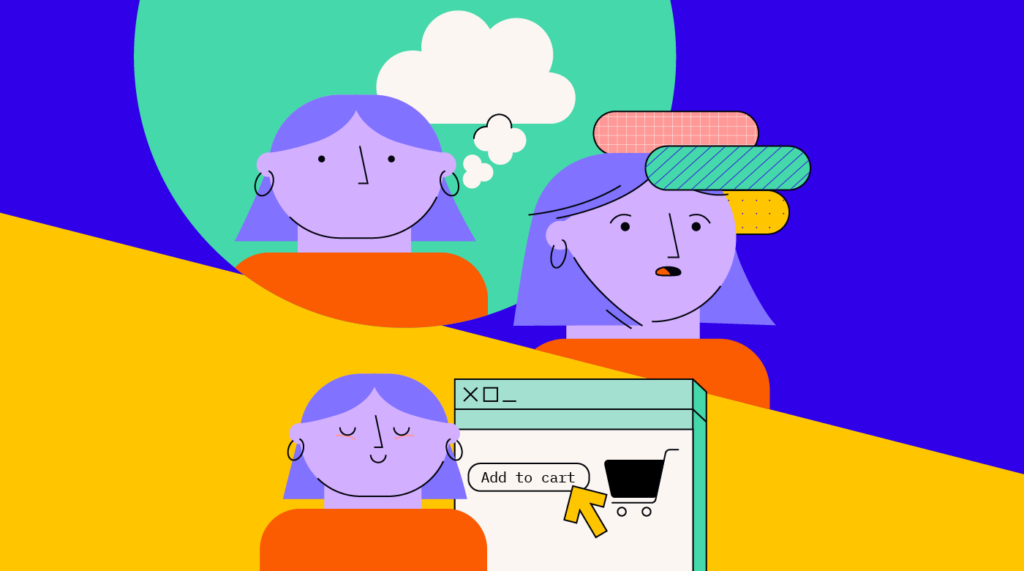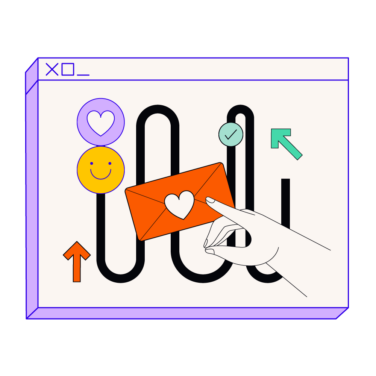Whether or not we're aware of it, we travel through all the customer journey stages on a near-daily basis. Picture this scenario: it's a scorcher of a day, you're out for a walk, and you notice a few neighborhood kids have set up a lemonade stand down the street. You quickly do the math: pay a few coins for a glass and reward the kids' entrepreneurial spirit, or walk further and shell out more at a cafe. The kids win out—and you have no regrets. They're polite, they're excited to have a real customer, and the lemonade is remarkably good. Before you know it, you're urging every neighbor you see to go support the little stand.
As many as 73% of consumers say that customer experience is an important factor in their purchasing decisions, and that experience begins with their very first impression of the brand. Understanding the stages of the customer journey enables businesses to offer the right messaging and the right services at the right time. If you want to build a loyal customer base from the get-go, here's what you need to know about the stages of the customer journey.
What Is the Customer Journey?
The customer journey, also known as the buyer's journey, is the set of interactions a current or potential customer has with your brand. In other words, the customer journey represents a buyer's overall experience—from the moment they recognize an unmet need, to their first impression of your business, and through to the post-purchase stages. Focusing on the buyer journey makes it easier to deliver high levels of customer satisfaction and increase retention, making it essential for marketing success.
Why Do Companies Need to Understand the Customer Journey?
It's important to understand the customer journey if you want to grow your customer base and generate repeat business. Unfortunately, many marketing professionals focus on individual interactions, or “touchpoints.” It's common for companies to ask for customer feedback about a single touchpoint. However, if you really want to stand out from the competition, you should be asking about the overall customer experience.
When you focus on the customer journey, you see your company through a customer's eyes. Mapping the buyer's journey provides valuable information about your employees, website, and in-store experience. This process gives you the opportunity to make improvements and helps you anticipate customers' needs, reducing the length of the sales cycle.
What Are the Stages of the Customer Journey?
The customer journey has seven stages. Each one is linked to some type of contact between the customer and your touchpoints. Direct contact typically occurs before a customer makes a purchase, while the customer is making a purchase, and after the customer makes a purchase.
Now that we've covered how customers are likely to come into contact with your business, it's time to go through the seven customer journey stages.

1. Out-of-Market Stage
During the out-of-market stage, customers in your target audience realize they have a problem. That problem could be anything from a bad case of the hot-'n-thirsties, to an old car that urgently needs replacing. If you sell products to other businesses, your prospective customers may be looking for ways to increase efficiency, reduce their expenses, or minimize employee turnover.
Once a customer knows they have a problem, they can start searching for potential solutions. During this stage, it's important to focus on search engine optimization, thoughtfully-targeted social media ads, and display ads. These three marketing techniques can get your company's name in front of potential buyers.
2. Trigger Stage
Once the customer reaches the trigger stage, they realize something needs to change. This "trigger" causes them to start searching for a solution to their problem. The right solution depends on what problem the customer is trying to solve. For example, the morning that car's engine refuses to turn over, its driver will immediately drop everything to evaluate their options.
During this stage, content marketing is especially effective, as it works to explain how your product or service meets your target customer’s needs. If a potential customer signed up for your email list during the previous stage, they'll now be highly receptive to emails about how your products or services can help them. Keyword-optimized blog posts are excellent for educating your target audience on your product while increasing your website’s visibility on search engines.
3. Initial Brand Consideration Stage
Now that the customer knows how to solve the problem, they establish an initial list of brands that may be able to fulfill their needs. During the initial brand consideration stage, the customer also creates a list of purchase criteria. For most customers, pricing is only one of many factors to consider during this stage, and rarely the most important. Customers are also evaluating product features, shipping and/or setup time, support options, other customer reviews, and the overall value of each competing product.
To ensure your company ends up on the list of contenders, keep content flowing out of your communication channels (like your blog and social media pages) to show potential customers that your offerings are a good fit for their needs. Don’t underestimate the effectiveness of word-of-mouth, either—customers trust other customers a lot more than they trust branded content. Make it easy for customers to post reviews publicly and monitor reviews to follow up on both positive and negative feedback.
4. Active Evaluation Stage
The active evaluation stage is when the customer begins evaluating each solution's pros and cons. They may read online reviews, ask friends for recommendations, or visit one of your stores. Every touchpoint is an opportunity to deliver a positive customer experience.
To target prospects at this stage of the journey, your marketing strategy should include product demos, in-store merchandising, Q&A sessions, case studies, testimonials, and other techniques to show potential customers that you have what they need. Your marketing strategy will need to change frequently to stay fresh and remain resonant with your target audience, so ensure you have great metrics reporting in place to continuously evaluate campaign performance and adjust your strategy.
5. Purchase Decision Stage
During the purchase decision stage, the customer finally chooses a product or service. Keep the buying process as barrier-free as possible and allow customers to save billing information to make future transactions fast and efficient. Now is also a good time to remind the new customer about your company's post-purchase support options.
6. Experience Stage
This stage is when customers experience your product or service. Your customers have made their purchase and are discovering for themselves what your offering is really like. For complex products, like software or specialized equipment, it's important to provide plenty of training materials, such as help guides and FAQ sheets. For B2B products and services, assigning the customer an account manager can help them through the onboarding process.
7. Loyalty Stage
During the loyalty stage, you should follow up to ensure existing customers are happy with their purchase. Nurture customer loyalty by offering perks such as referral programs or sending updates when new features or promotions are released. Make sure customer support options are clear, accessible, and intuitive, and monitor feedback by tracking key customer satisfaction metrics. Keeping existing customers is always more cost-effective than acquiring new ones, so it’s a smart bet to invest in customer retention.
How to Map the Customer Journey
A customer journey map is a visual representation of how customers interact with your brand. It's important for companies of all sizes to engage in journey mapping because it provides insight into some pain points that hurt the customer experience.
The process of customer journey mapping has two main stages: mapping out a list of touchpoints and then creating a user journey for each touchpoint. To create an effective journey map, it's important to develop a user journey for more than one buyer persona.
Mapping Touchpoints
A touchpoint is any interaction between a customer and a business. An interaction could be something as simple as a customer seeing one of your sponsored search engine ads or coming across your Twitter profile. Here are some common examples:
- Online advertisements
- Social media profiles
- Landing pages
- E-commerce website
- Television advertisements
- In-store events
- Product packaging
- Emails
- Billing documents
Customers encounter these touchpoints at different stages of the buyer journey, but all stages are equally important. Creating a customer journey map helps you pay close attention to the touchpoints in each stage. This process ensures that your company delivers an excellent customer experience.
Once you map out the touchpoints, ask yourself what your company's marketing team can do to improve each interaction. Here are a few considerations:
- Does your site have broken links that affect the user experience?
- Is there enough content on your site to help customers understand exactly what your company offers?
- Is your digital marketing strategy well-aligned with your customers' needs?
- Does your product packaging contain enough information to help customers make informed decisions?
- Are your brick-and-mortar stores clean and inviting?
- Do your email newsletters have relevant subject lines?
- Do you respond quickly to customers who contact you via social media?
- Are your billing practices fair and easy to understand?
Creating User Journeys
Now that you understand all the interactions that occur between your customers and your business, you can map out the entire customer journey. First, create buyer personas to guide you. A buyer persona represents your ideal customer. Your personas should contain the ideal customer's challenges, lifestyle, and decision-making processes.
Imagine you own an auto parts store that sells to individual consumers and local mechanic shops. You'd have two buyer personas, one for the consumer and one for the business owner. Each one has different needs and challenges, so creating a persona for each one makes it easier to personalize your marketing efforts.
Now you can create a journey map for each persona, documenting their behaviors, thoughts, and feelings as they move from one stage of the buyer's journey to the next. Here's an example journey map for an interaction with your website:
- The customer enters a keyword into their favorite search engine.
- Your company's website appears on the first page of the search results, prompting the customer to click a link to one of your pages.
- The customer reads the content on the page and then clicks a link to go to another page of your website.
- Intrigued by a featured product, the customer clicks a button and fills out a request for more information.
- You receive the request and respond by sending the customer a welcome email.
Learn More About Mapping the Customer Journey
For more tips on improving the customer experience, sign up for our newsletter or read these related blogs:


